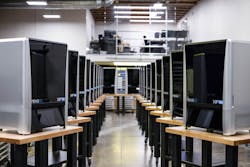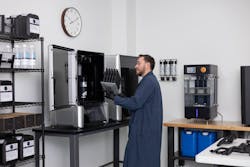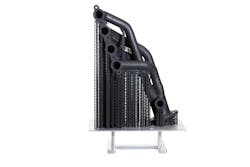Speed, size give Nexa3D printer leg up on large volumes
By Karen Hanna
New 3D printer technology from Nexa3D offers big — and, in the company's words, "blazing fast" — possibilities.
"The world is basically about to see a creative explosion that’s being fueled by Nexa3D. … My hat’s off to them. They have great technology, they’ve got a great vision for it,” said Glen Mason, director of advanced manufacturing for Chicago-based Wilson Sporting Goods Co., which uses Nexa3D's Xip Pro technology to make sacrificial molds from thermosets.
The aim is a printer that “can get us beyond … 10,000 into the hundreds of thousands [of parts],” said Michael Currie, Nexa3D’s chief product officer, during a company webinar about the new technology.
Part quality is on par with injection molding, said Lewis Simms, head of industrial product marketing for Nexa3D.
Using Nexa3D’s proprietary liquid-crystal-display (LCD)-based Lubricant Sublayer Photocuring technology, the Xip Pro focuses ultraviolet light on a pool of photopolymer liquid resin to transform it into structural plastic.
Light-emitting diodes (LEDs) and LCDs have been used to build upon older methods of curing light-sensitive resins. Previous approaches used a laser source, with later methods employing a lamp source instead.
The new approach avoids the distortion parts made by older printers“You’re able to get down to accuracies less than a human hair — less than half the human hair — with this level of detail,” he said.
The Xip Pro represents an evolution toward larger-scale production capabilities, Mason observed.
“The ultrafast printing that Nexa[3D] provides isn’t just the layer speed; it’s the actual build plate, and overall volume size,” he said. “So, I like both. I like the larger XY dimensions because I can get more things on the plate and print at a low-aspect ratio quickly. You could picture something that was rectangular; historically, I would have had to print that vertically, and it might have taken seven or eight hours to do that. Now, I can lay it down on the plate and print it in 30 minutes.”
But the Xip Pro’s features ensure more than just fast prints.
“With the Xip Pro, I think I’m probably printing 10 times faster than I was before. And what that also means is I have fewer design inputs; I don’t have to cut the mold into as many small pieces,” Mason said.
“They can house not just one build, but multiple builds, of parts at each stage that you’re pumping through at volumes,” he said.
Contributing to the printer’s speed is its software, Currie explained.
“We have an onboard computer with lots of ample space for future opportunity for upgrades. And, as you know, software is a huge component of any piece of equipment now, and we will always be updating and developing new feature sets,” he said.
The system allows users to manage prints across multiple printers at once.
Like Nexa3D’s other open-platform printers, the resin-based Xip Pro uses a multitude of resins — making it compatible with many manufacturers’ applications.
With the speed and quality it delivers, the Xip Pro provides more options for manufacturers, Simms said during the webinar.
“Because those processes print so fast and use more-robust materials, they can provide the performance, as well ... because with 3D printing ... you had to make a choice. You had to say, ‘If I want a really accurate, detailed, high-quality part, I’ve got to sacrifice speed, and it’s got to be super-slow,’ ” he said. “... The latest versions of resin 3D printing … speeds up that process, while still providing all that detail and accuracy and precision that you need out of a final production part. So, now, it’s printing without compromise.”
Karen Hanna, senior staff reporter
Contact: Nexa3D, Ventura, Calif., 800-797-0633, www.nexa3d.comVital Statistics
| Build volume | 19.5 liters |
| Build dimensions | 16.1 inches by 11.5 inches by 6.4 inches |
| Printer dimensions | 24.5 inches by 17.6 inches by 35.25 inches |
| Build speed | Up to 9.4 vertical inches per hour. Depending on the material and settings, the printer can fill the build volume in under 2 hours. |
| Materials | The Xip Pro is an open-platform printer; available materials include ABS, PP and polyetheretherketone. As of mid-May, Nexa3D has validated 20 of its 33 materials for its newest printer. |
About the Author
Karen Hanna
Senior Staff Reporter
Senior Staff Reporter Karen Hanna covers injection molding, molds and tooling, processors, workforce and other topics, and writes features including In Other Words and Problem Solved for Plastics Machinery & Manufacturing, Plastics Recycling and The Journal of Blow Molding. She has more than 15 years of experience in daily and magazine journalism.



